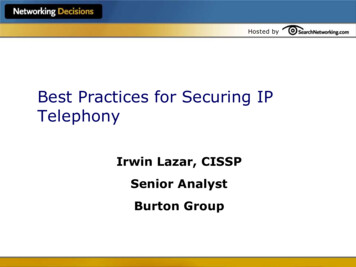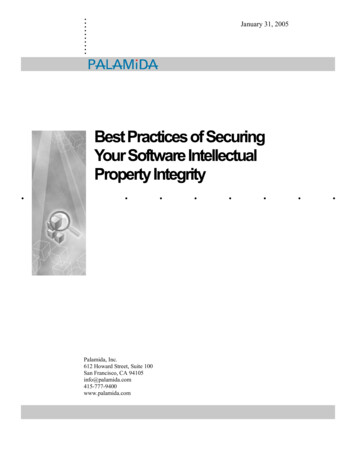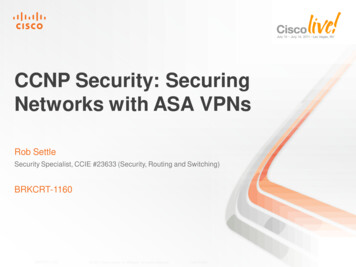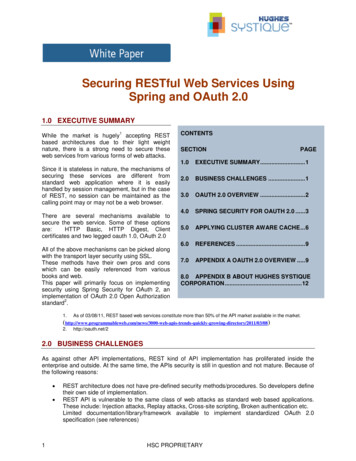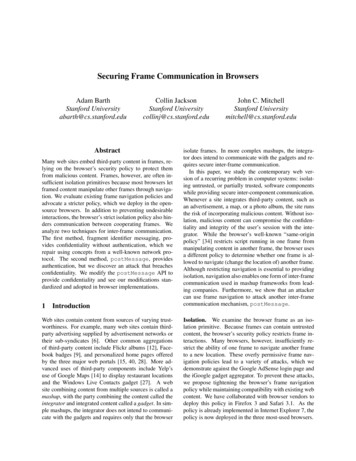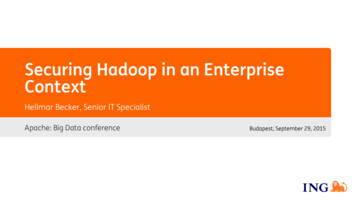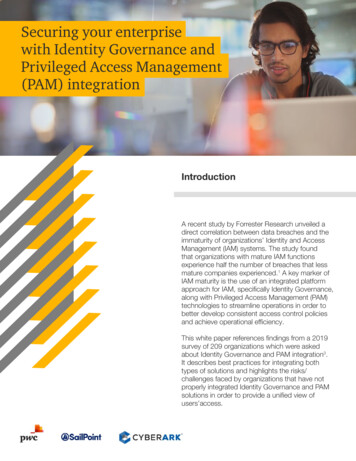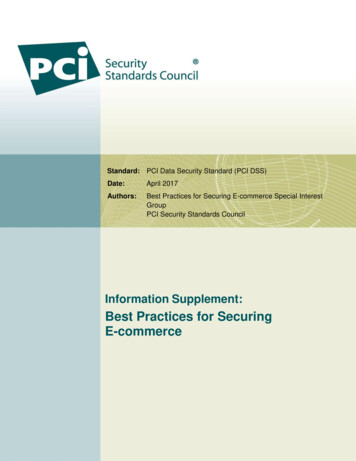
Transcription
Standard: PCI Data Security Standard (PCI DSS)Date:April 2017Authors:Best Practices for Securing E-commerce Special InterestGroupPCI Security Standards CouncilInformation Supplement:Best Practices for SecuringE-commerce
Information Supplement Best Practices for Securing E-commerce April 2017Document ChangesDateDocument VersionDescriptionPagesJanuary 20131.0Initial releaseJanuary 20171.1Expanded and revisedcontent based upon theSecuring e-CommerceSpecial Interest GroupVariousApril 20171.2Corrected entries in table,Section 2.7 typographical andgrammatical errorsVariousAllThe intent of this document is to provide supplemental information. Information provided here doesnot replace or supersede requirements in any PCI SSC Standard.ii
Information Supplement Best Practices for Securing E-commerce April 2017Table of ContentsDocument Changes . ii1Introduction . 51.1 Background . 51.2 Intended Audience . 71.3 Terminology . 72Understanding E-commerce implementations . 82.1 Shared-Management E-commerce – URL Redirects . 82.2 The iFrame . 102.3 The Direct Post Method (DPM) . 132.4 JavaScript Form . 152.5 The Application Programming Interface (API) . 172.6 Wholly Outsourced E-commerce Solutions . 192.7 Advantages and Disadvantages of E-commerce Methods . 202.8 PCI DSS Validation Requirements . 212.9 The Intersection between E-commerce and Other Payment Channels . 222.10 E-commerce Scoping Considerations. 232.11 Additional Considerations . 263Public Key Certificate Selection . 343.1 Brief History on SSL and TLS . 343.2 Selecting the Certification Authority . 343.3 Selecting the Appropriate Type of Public Key Certificates . 353.4 Tools for Monitoring and Managing E-commerce Implementations . 364Encryption and Digital Certificates . 374.1 Certificate Types (DV, OV, EV) and Associated Risks . 374.2 TLS 1.2 Configurations . 394.3 Merchant Questions on Certificate Types and TLS Migration Options . 405Guidelines to Determine the Security of E-commerce Solutions . 445.1 E-commerce Solution Validation . 445.2 Validation Documentation . 455.3 PCI DSS Requirement Ownership . 466Case Studies for E-commerce Solutions . 476.1 Case Study One: Fully Outsourced Redirect . 476.2 Case Study Two: Fully Outsourced iFrame . 496.3 Case Study Three: Partially Outsourced (JavaScript-Generated Form) . 516.4 Case Study Four: Merchant Managed (API) . 537Best Practices . 557.1 Know the Location of all Your Cardholder Data . 557.2 If You Don’t Need It, Don’t Store It . 557.3 Evaluate Risks Associated with the Selected E-commerce Technology . 557.4 Service Provider Remote Access to Merchant Environment . 567.5 ASV Scanning of E-commerce Environments . 567.6 Penetration Testing of E-commerce Environments . 56The intent of this document is to provide supplemental information. Information provided here doesnot replace or supersede requirements in any PCI SSC Standard.iii
Information Supplement Best Practices for Securing E-commerce April 20177.77.87.97.107.11Best Practices for Securing e-Commerce . 57Implement Security Training for all Staff . 58Other Recommendations . 58Best Practices for Consumer Awareness . 58Resources . 59Acknowledgments . 62About the PCI Security Standards Council . 64The intent of this document is to provide supplemental information. Information provided here doesnot replace or supersede requirements in any PCI SSC Standard.iv
Information Supplement Best Practices for Securing E-commerce April 20171 IntroductionElectronic commerce, commonly known as e-commerce, is the use of the Internet to facilitate transactions forthe sale and payment of goods and services. E-commerce is a card-not-present (CNP) payment channel andmay include: E-commerce websites accessible from any web-browser, including “mobile-device friendly” versionsaccessible via the browser on smart phones, tablets, and other consumer mobile devices “App” versions of your e-commerce website, i.e., apps downloadable to the consumer’s mobile device orsaving of the URL as an application icon on a mobile device that has online payment functionality(consumer mobile payments)The objective of this information supplement is to update and replace the PCI DSS E-commerce Guidelinespublished in 2013. This information supplement offers additional guidance to that provided in PCI DSS and iswritten as general best practices for securing e-commerce implementations. All references in this documentare for PCI DSS Version 3.2.The guidance focuses on the following: Different e-commerce methods, including the risks and benefits associated with each implementation aswell as the merchant’s responsibilities The selection of public key certificates and certificate authorities appropriate for a merchant’senvironment Questions a merchant should ask its service providers (certificate authorities, e-commerce solutionproviders, etc.) General recommendations for merchants1.1BackgroundAn e-commerce solution comprises the software, hardware, processes, services, and methodology thatenable and support these transactions. Merchants choosing to sell their goods and services online have anumber of methods to consider, for example: Merchants may develop their own e-commerce payment software, use a third-party developed solution,or use a combination of both. Merchants may use a variety of technologies to implement e-commerce functionality, including paymentprocessing applications, application-programming interfaces (APIs), Inline Frames (iFrames), orpayment pages hosted by a third party. Merchants may also choose to maintain different levels of control and responsibility for managing thesupporting information technology infrastructure. For example, a merchant may choose to manage allnetworks and servers in-house, outsource management of all systems and infrastructure to hostingThe intent of this document is to provide supplemental information. Information provided here doesnot replace or supersede requirements in any PCI SSC Standard.5
Information Supplement Best Practices for Securing E-commerce April 2017providers and/or e-commerce payment processors, or manage some components in house whileoutsourcing other components to third parties.Merchants may also decide to engage a third party to perform services that support their e-commercesolution. The service provider or the services may be considered in scope for a merchant’s PCI DSScompliance if the security of the solution is impacted by this service and the service provider has notperformed its own assessment. For more information, see the section on “Use of Third-Party ServiceProviders/Outsourcing” in the PCI DSS. Examples of common e-commerce support services that may affectcardholder data security include:a) Software development on behalf of the merchantb) Hosted website, either fully or partially managed by the solution providerc) Hosted data center/network/physical systems in support of a websited) Shopping-cart software (including software that hands off transactions or customer information to othersystems)e) Order-management software such as chargebacks, returns, etc. that may have access to cardholderdataf)Other hosting options (offline data storage, backups, etc.)—depending on whether the data is encryptedand whether the service provider has access to the decryption keysg) Merchant plug-ins to support payment brand and issuer authentication mechanismsh) Managed services, including WAF or log-management servicesi)Any service that transmits cardholder data (CHD) or handles this data in some other fashion on behalf ofthe merchant services that have access to the checkout or payment-processing flow, including thosewithout a need to access cardholder data, third-party fraud analysis, or analytics toolsNo matter which option a merchant may choose, there are several key considerations to keep in mindregarding the security of cardholder data, including: No option completely removes a merchant’s PCI DSS responsibilities. Regardless of the extent ofoutsourcing to third parties, the merchant retains responsibility for ensuring that payment card data isprotected. A merchant is responsible for performing due diligence to ensure the service provider isprotecting the CHD shared with it in accordance with PCI DSS. It is the acquirer or payment card brand,that determines whether a merchant must conduct an onsite assessment or is eligible for a SelfAssessment Questionnaire (SAQ). Third-party relationships and the PCI DSS responsibilities of the merchant and each third party shouldbe clearly documented in a contract or service-level agreement to ensure that each party understandsand implements the appropriate PCI DSS controls. More information on these relationships can be foundin the Third-Party Security Assurance Information Supplement on the PCI SSC website.The intent of this document is to provide supplemental information. Information provided here doesnot replace or supersede requirements in any PCI SSC Standard.6
Information Supplement Best Practices for Securing E-commerce April 2017 It is recommended the merchant monitor connections and redirections between the merchant and thethird party since the connections can be compromised. The merchant should ensure no changes haveoccurred and that the integrity of the e-commerce solution is maintained. It is recommended that e-commerce payment applications, such as shopping carts, be validatedaccording to PA-DSS, and confirmed to be included on PCI SSC’s list of Validated PaymentApplications. For in-house developed e-commerce applications, PA-DSS should be used as a bestpractice during development.1.2Intended AudienceThis guidance is intended for merchants who use or are considering use of payments through e-commercetechnologies in their cardholder data environment (CDE) as well as third-party service providers that providee-commerce services, e-commerce products, or hosting/cloud services for e-commerce merchants. Thisdocument may also be of value for assessors reviewing e-commerce environments as part of a PCI DSSassessment.The guidance is applicable to merchants of all sizes, budgets, and industries. This document will be mostuseful to those merchants that have a solid understanding of their current e-commerce solution andenvironment. For small-to-medium sized merchants who do not know their e-commerce solution orenvironment, the recommendation is to review the PCI SSC Payment Protection for Small Merchants1 firstand then review the guidance in this document.This document is not intended as an endorsement for any specific technologies, products, or services butrather as recognition that these technologies exist and may influence the security of payment card data.1.3TerminologyThe following term is used throughout this document: Payment Service Provider (PSP): A PSP offers a service that directly facilitates e-commercetransactions online via its relationship with acquiring member banks of payment card brands. Thiscategory includes online payment processors, payment “gateway” service providers, virtual terminalservices, and certain e-wallet or prepaid services that also process credit card payment for non-accountholders at the point of sale. PSP services are discussed in this document.For additional information on terms or definitions, please review the PCI DSS and PA-DSS Glossary ofTerms, Abbreviations, and Acronyms.1This family of documents includes Guide to Safe Payments, Common Payment Systems, Questions to ask Your Vendors,and Glossary of Payment and Information Security TermsThe intent of this document is to provide supplemental information. Information provided here doesnot replace or supersede requirements in any PCI SSC Standard.7
Information Supplement Best Practices for Securing E-commerce April 20172 Understanding E-commerce implementationsThis section discusses different e-commerce implementations along with their potential impact to themerchant, recommendations for secure implementation, advantages and disadvantages of theimplementation type, potential applicability of PCI DSS SAQ, other e-commerce implementations, scopingconsiderations, and additional features a merchant may want to consider. Some common e-commerceimplementations include: Merchant-managed e-commerce implementations:oProprietary/custom-developed shopping cart/payment applicationoCommercial shopping cart/payment application implementation fully managed by themerchantShared-management e-commerce implementations:oURL redirection to a third-party hosted payment pageoAn Inline Frame (or “iFrame”) that allows a payment form hosted by a third party to beembedded within the merchant’s web page(s)oEmbedded content within the merchant’s page(s) using non-iFrame tags.oDirect Post Method (Form)oJavaScript FormoMerchant gateway with third-party embedded application programming interfaces (APIs)Wholly outsourced e-commerce implementationsThese examples represent some of the most common implementations and are not all inclusive of everydeployment option that may exist. Each implementation of hardware components, software applications, andhosting/service models will need to be individually evaluated to determine how this guidance may apply.The following sections discuss these common e-commerce implementations in detail and include basic PCIDSS scoping guidance.2.1Shared-Management E-commerce – URL Redirects2.1.1What is a URL Redirect?In the URL redirection model, the cardholder is redirected from the merchant’s website to a third-partypage. The cardholder then enters their account data into a payment page hosted by the third-partypayment service provider (PSP). This may also be called a “punch out” since customers and applicationusers are sent to a PSP’s web pages. This is generally noticeable to the customer as the merchant’swebsite URL—e.g., http://www.merchant.example.com—changes to that of the PSP—e.g.,https://www.psp.example.com.The intent of this document is to provide supplemental information. Information provided here doesnot replace or supersede requirements in any PCI SSC Standard.8
Information Supplement Best Practices for Securing E-commerce April 20172.1.2The Redirect Process1. Merchant website sends a redirect command to the customer’s browser.2. The customer’s browser then requests a payment form from the PSP.3. The PSP creates the payment form and sends to the customer’s browser.4. The customer’s browser displays the PSP’s payment form.5. The customer enters account data and sends to the PSP.6. The PSP receives the account data and sends it to the payment system for authorization.Figure 1 – An Example Redirect Payment FlowThe intent of this document is to provide supplemental information. Information provided here doesnot replace or supersede requirements in any PCI SSC Standard.9
Information Supplement Best Practices for Securing E-commerce April 20172.1.3Merchant ImpactAs account data is not coll
The objective of this information supplement is to update and replace the PCI DSS E-commerce Guidelines published in 2013. This information supplement offers additional guidance to that provided in PCI DSS and is written as general best practices for securing e-commerce implementations. All
